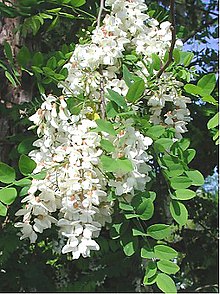Robinia
| Robinia | |
|---|---|

| |
| Robinia pseudoacacia | |
| Scientific classification | |
| Kingdom: | Plantae |
| Clade: | Tracheophytes |
| Clade: | Angiosperms |
| Clade: | Eudicots |
| Clade: | Rosids |
| Order: | Fabales |
| Family: | Fabaceae |
| Subfamily: | Faboideae |
| Tribe: | Robinieae |
| Genus: | Robinia L. (1753) |
| Species[1] | |
|
4; see text | |
| Synonyms[1] | |
| |
Robinia is a genus of flowering plants in the family Fabaceae, tribe Robinieae, native to North America. Commonly known as locusts,[2] they are deciduous trees and shrubs growing 4–25 metres (13–82 ft) tall. The leaves are pinnate with 7–21 oval leaflets. The flowers are white or pink, in usually pendulous racemes. Many species have thorny shoots, and several have sticky hairs on the shoots.
The genus is named after the royal French gardeners Jean Robin and his son Vespasien Robin, who introduced the plant to Europe in 1601.
The number of species is disputed between different authorities, with as few as four recognised by some authors,[3][1] while others recognise up to 10 species. Several natural hybrids are also known.[1]
Some species of Robinia are used as food by caterpillars of Lepidoptera, including such moths as the brown-tail (Euproctis chrysorrhoea), the buff-tip (Phalera bucephala), the engrailed (Ectropis crepuscularia), the giant leopard moth (Hypercompe scribonia), the locust underwing (Euparthenos nubilis), and Gracillariidae leaf miners like Chrysaster ostensackenella, Macrosaccus robiniella and Parectopa robiniella.
Toxicity
[edit]All species produce toxic lectins, throughout the entire plant, with the exception of the flowers.[4][5] The flowers are used in teas and in pancakes,[6] and are consumed as fritters in many parts of Europe.[7][8][9][10]
Species
[edit]- Robinia hispida L.– bristly locust
- Robinia hispida var. rosea (syn. R. boyntonii)
- Robinia hispida var. nana (syns. R. elliottii & R. nana)
- Robinia hispida var. kelseyi (syn. R. kelseyi)
- Robinia neomexicana A.Gray (syn. R. luxurians) – New Mexican locust
- Robinia pseudoacacia L. – black locust, false acacia
- Robinia viscosa Michx. ex Vent. – clammy locust
- †Robinia zirkelii[14]
Hybrids
[edit]- Robinia × ambigua (R. pseudoacacia × R. viscosa) – Idaho locust
- Robinia × holdtii (R. neomexicana × R. pseudoacacia)
- Robinia × longiloba (R. hispida × R. viscosa)
- Robinia × margarettiae (R. hispida × R. pseudoacacia)
References
[edit]- ^ a b c d Robinia L. Plants of the World Online. Retrieved 19 September 2023.
- ^ NRCS. "Robinia". PLANTS Database. United States Department of Agriculture (USDA). Retrieved 22 October 2015.
- ^ "Robinia". LegumeWeb. International Legume Database & Information Service.
- ^ Poisonous Plants List. Ivydene Horticultural Services.
- ^ Handbook of Poisonous and Injurious Plants. 2. Auflage. Springer, 2006. ISBN 0-387-31268-4, S. 33.
- ^ "Acacia flowers—a potent cough mixture". European Union Development Fund. Archived from the original on 2014-11-22. Retrieved 2014-05-13.
- ^ "Acacia flower fritters". Morrison, Médoc, France. 29 May 2013. Archived from the original on 9 June 2013. Retrieved 13 May 2014.
- ^ "Frittelle di Fiori d'Acacia (Black Locust Flower Pancakes)". Cooking and traveling in Italy. 22 April 2011.
- ^ "ACACIA FLOWER FRITTERS". Tatty Apron. 3 June 2013.
- ^ "Riaperta la stagione della cacia". Unazebrapois. 2012.
- ^ R. viscosa var. hartwegii. ITIS.
- ^ E. Koehne. 1913. Eine neue Robinie
- ^ "Robinia viscosa var. hartwigii". Germplasm Resources Information Network. Agricultural Research Service, United States Department of Agriculture. Retrieved 17 December 2017.
- ^ Lavin M, Wojciechowski MF, Gasson P, Hughes C, Wheeler E (2003). "Phylogeny of Robinioid Legumes (Fabaceae) Revisited: Coursetia and Gliricidia Recircumscribed, and a Biogeographical Appraisal of the Caribbean Endemics" (PDF). Systematic Botany. 28 (2): 387–409. doi:10.1043/0363-6445-28.2.387 (inactive 1 November 2024). Archived from the original (PDF) on 16 June 2021. Retrieved 22 November 2013.
{{cite journal}}: CS1 maint: DOI inactive as of November 2024 (link)
